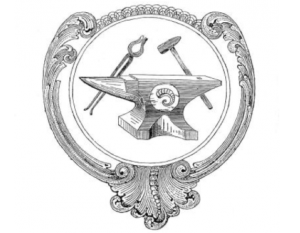Repoussé VI: Leaf Processes
This is a continuation of the writings of the late repoussé artisan Nahum “Grandpa” Hersom. Nahum gave me a plethora of notes and drawings. I feel compelled to share his knowledge, to honor Nahum and his life’s work. Plus, there are few books on this subject. These writings should be preserved, for those who wish to learn, and also for the ages. I am transcribing verbatim unless otherwise specified.
Leaf Processes
1.) Design and lay out leaf, using ABANA (ABANA’s 10th Anniversary edition of the “Anvil’s Ring”, Spring 1983, Volume 11, Number 1-edited by D.N.) and Metzger’s books (“Die Kunstsclosserie” 1927-edited by D.N.) as guides. Use Hersom’s layout “T” tool to help design leaf patterns.
2.) Use copy machine to enlarge or shrink size of leaf if not correct.
3.) Make and cut out paper pattern. I glue copy machine paper patterns to manilla file holder card and cut out. Punch corners of leaf pattern before cutting out to have good round corners.
4.) Double check segments of leaf to see if they will clear or overlap when leaf is bent to fit scroll work. Make corrections to open or closed leaf segments to fit design. You can use cut-and-tape “quicky” methods of revamping leaf segmnets of pattern.
5.) If pattern is incorrect, determine method to cut out leaf: shear, band saw, chisel cut, plasma arc or laser cut. Shop bench shear work is OK for a few leaves, but if hundreds are to be cut, check laser or plasma arc, depending on outline of the leaf. Laser cuts very clean and sharp points. Plasma makes 1/8″ cut, so is more crude, and needs extra grinding of edges (with 1/8″ grind wheel or sanding belts. 2″ belts do fine.) Laser or plasma cut leaves-anneal (actually should read “normalize” rather than “anneal”-edited by D.N.) edges before hammering. Cold roll leaves have to be annealed (“normalized”-edited by D.N.) -see welding heat treating notes for recommended process.
6.) To shear leaves if more than one or two, cut tin pattern, as edges of paper patterns tend to shred away. Use cheap flat black paint on surface to see scribed line.
7.) To band saw, make multiple copies on copy machine and glue to metal with rubber cement (stationary store) (see band saw blade in supplies) Set saw blade and speed for cutting metal. Use a 1″ high pedistal when cutting out leaves. See drawing and information in workbook.
8.) Before cutting leaf, the inner corners must either be punched out or a hole drilled through leaf to protect corner from splitting when hammering, called “xyz” marks.
9.) A jig saw with fine blades or air craft snips do well on some metals of various thicknesses (see supply sheet for tool catalogue.)
10.) Use red sharpie pen for marking leaf work. For some work I make tin segment patterns so I can duplicate the lines on work from leaf to leaf.
11.) Tools used to form a leaf are separated from other tools and put in cans near vise. Also, I sometimes mark tools 1, 2, 3, with felt pen in order of sequence in use. Tools laid on bench tend to pile up and seem to get lost.
12.) Before hammering, file edges of leaves and corners to remove all burrs, as these will start splits and may ruin leaves.
13.) Also, by filing edges of leaves, one cleans up contours on segments to make both sides of leaf symmetrical and even. To be able to file all segments and recesses on leaves, you bend segments of leaf out of the way. (You can file corners better if you grind gripper teeth off a pair of simple pliers and round jaw parts. Grind smooth. This prevents scratch marks on leaves-especially on non-ferrous metals.) After filing edges, wire brush to remove filing burrs. Use fine wire brush as it makes a smooth velvet like finish. In fact, I wire brush as I hammer lines into leaves so I can better see edges and contours. (Wire brush removes some hammer marks and layout pencil lines and smudges.) (Nahum is talking about a “power wire brush”, mounted in pedistal grinder-edited by D.N.)
14.) Punch paper or tin patterns with small rectangle slots that will follow lines and configurations, that will later be hammered into shapes or designs. Place pattern on leaf, after it has been filed and wire brushed to remove sharp burrs. Scribe all slots through pattern, remove pattern and connct spots with scribe or red sharpie pen.
(End of this installment.)
…Dan Nauman
